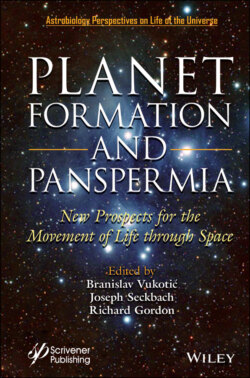Читать книгу Planet Formation and Panspermia - Группа авторов - Страница 30
4.1 Introduction
ОглавлениеOver the last two decades, studies of galactic habitability have matured significantly. From rudimentary pioneering works, primarily based on metallicity gradients, to sophisticated numerical models that consider a multitude of parameters, from cosmological to stellar scales. However, there is still much room for improvement, given the significantly different conclusions from various models, as well as overall uncertainty about the underlying parameter distributions and averaging procedures.
One of the main factors affecting continuous habitability is the movement of stars within the host galaxy. Apart from secular changes in galactic environment, the stars move and experience different parts of the galaxy with different habitable parameters, during the lifetime of the star. While the general habitability parameters at a certain galactocentric radius might be considered as constant, the stars with substantial eccentricity of their galactic orbits, vertical oscillations, or even galactic rotational speeds that are different from the speed of the spiral pattern might endure significant changes of their galactic environment. In addition, recent works have pointed to a significant amount of stellar radial migrations. This can produce stellar trajectories passing through various parts of the galactic disk, characterized by large variations in habitability.
Potential interstellar panspermia material would also be moving in the same galactic potential as the stars. In addition, the smallest bodies could also move under other, non-gravitational forces such as light pressure (suggested in early work of Swante Arrhenius [4.4]), magnetic fields, and possibly even something analogous to the Yarkovsky effect. Various kinds of small bodies and rogue planets are likely wandering around through galactic interstellar space [4.29]. With a potential to carry panspermia material, such bodies could affect life in stellar systems by getting picked up by the stars that are found in the vicinity. At the start of the panspermia process, the panspermia material is thought to be blasted off in rocks from the host body. Compared with the galactic scales, processes on life hosting sites (planets and smaller bodies) happen on small scales. Introduction of panspermia to galactic habitability models can therefore couple the life hosts to the galactic environment and large-scale galactic processes. So far, most models have considered that life hosting sites are only oneway dependent on galactic processes. Once life arises, its survival depends on the frequency of nearby stellar explosions, stellar passages, activity of the galactic nucleus, etc. However, panspermia could modify such models with positive habitability feedback. When life arises, besides enduring the galactic environment, it could also contribute to the spread of life in that environment. This is similar to the well-known Huygens–Fresnel principle in classical wave optics, where every point on a wavefront is treated as a source of interfering wavelets. Similar parallels to other type of processes have been demonstrated [4.24].
The discovery of live 250 Myr old halophilic bacteria in a grain of salt [4.31] implies the possibility that panspermia could be viable even on galactic time scales. The Galactic Solar orbit lasts a little under a quarter of a billion years. On even shorter timescales, there is a possibility that neighboring stellar systems could exchange material. The recent discoveries of the Oumuamua [4.26] asteroid-like object and comet 2I/Borisov [4.17, 4.21], that show hyperbolic orbital characteristics of extrasolar bodies, have demonstrated that external objects can traverse the Solar system, which makes it possible that some of them could eventually be captured or sampled. The galaxies are the main form of organization of matter in the universe. Galactic evolution and underlying processes link the evolution of matter on stellar/planetary scales and smaller, to the overall evolution of the universe. In a similar way, stars with their planetary systems can be considered as pivotal objects for the evolution of life. While their evolution and appearance are influenced by galactic scale processes, they provide suitable conditions for biochemistry to take place. Some of these processes might arguably take place in the interstellar molecular and dust clouds, but these are also the birthplaces of stars and planets.
Following the overall organization of matter in the universe, we discuss the panspermia prospects from stellar to cosmological levels.
